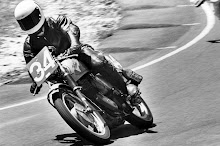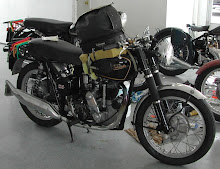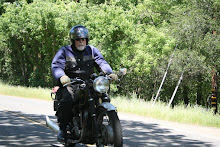 With the huge figures quoted today for the MotoGP top runners, one often wonders what did the top pre-war runners get? Stanley Woods was on his peak in the late 1930s and won for Velocette an IOM TT in 1938 and then again in 1939, the first since 1929.
With the huge figures quoted today for the MotoGP top runners, one often wonders what did the top pre-war runners get? Stanley Woods was on his peak in the late 1930s and won for Velocette an IOM TT in 1938 and then again in 1939, the first since 1929.“A long time between drinks” is the old saying……
I’m fortunate to have the documentation between Stanley and Veloce Ltd for some of those years and in particular the 1938 IOM TT races.
Stanley during practice on the 348cc Junior TT Velocette.
Firstly, Stanley was contracted to Veloce Ltd in 1938 to ride in four events…three Irish road races…The Leinster 100, The North-West 200 and The Ulster GP and of course the other being the IOM TT races.
For this he was paid a yearly retainer of £400.
Veloce also agreed to pay the race meeting entry fee and insurance.
I have no figures for the insurance, but the TT entry fee for 1937 was £10, likely the same in 1938.
A lot of money in those days…
They also agreed to pay all Stanley’s expenses for the TT.
This totalled £23.14.6, made up of….
20 days personal expenses @ 20/- = £20. 0. 0
Return ticket, Dublin – IOM = £0. 18. 6
Return cabin on boat = £1. 1. 0
Unloading cycles and boxes from boat = £1. 0. 0
Road tax, “M.G.” car and cycles = £0. 15.0
Following his Junior TT victory, the IOM governor contratulates him. Stanley's wife Mildred is behind with their 16mm movie camera. Yes film exists of late 1930s TT events.
 Stanley won the Junior TT and came second in the Senior TT.
Stanley won the Junior TT and came second in the Senior TT.The ACU paid him a bonus of £150 for riding in the TT…a “name”…
Ferodo Ltd paid him a bonus of £50 for using their friction materials.
Telacamit paid him a bonus of £30 for using their grease nipples.
KLG Sparking Plugs Ltd. paid him a bonus of £50 for using their spark plugs.
Dunlop Rubber Co. Ltd. paid him a bonus of £150 for using their tyres and tubes.
Webb paid him a bonus of £8 for using their front forks.
ACU paid him prize money of £100 for winning the Junior TT.
Veloce paid him a bonus of £250 for winning the Junior TT.
ACU paid him prize money of £70 for second place in the Senior TT.
Veloce Ltd. paid him a bonus of £100 for second place in the Senior TT.
All this totals to £981.14.6 plus the TT entry and insurance figures and of course his yearly retainer and he was chasing Veloce Ltd for a “Bowdenex bonus” for using Bowden control cables, unresolved in the correspondence I have!
Now a new production racer in 1938, that is a Mk.7 KTT cost £105.
So Stanley earned over 9 times the cost of a then current production racer. How much is a Yamaha production racer today? Likely some AUD$30,000….so you could say he netted the equivalent in today’s money of AUD$295,000…ouch!!
Left click on photos to enlarge.
































.jpg)
+viceroy+engined.jpg)
.jpg)































